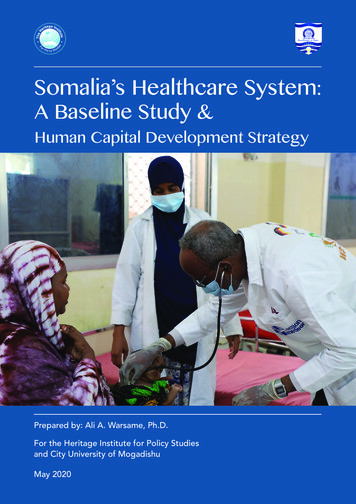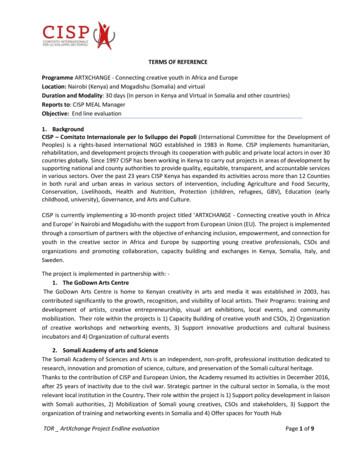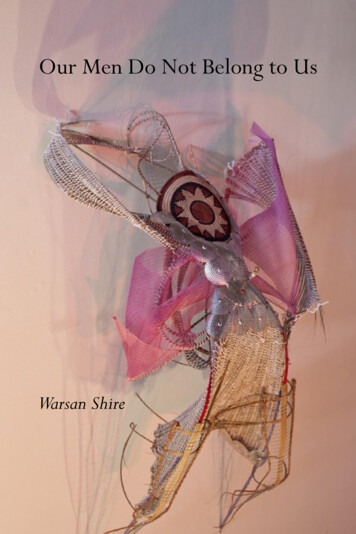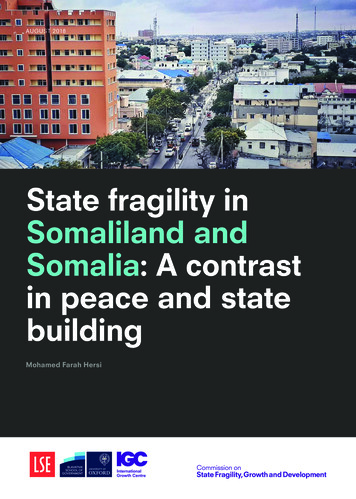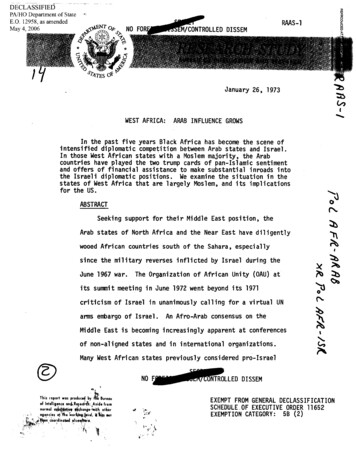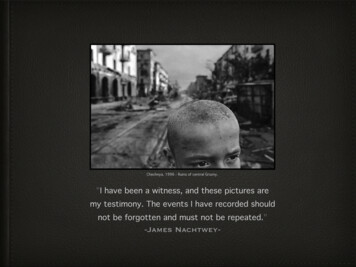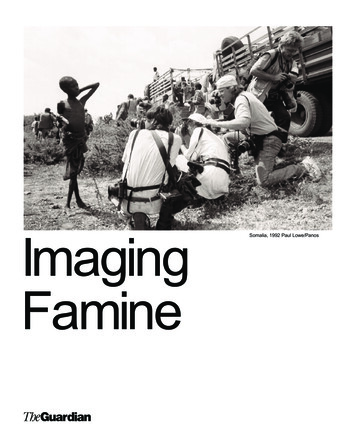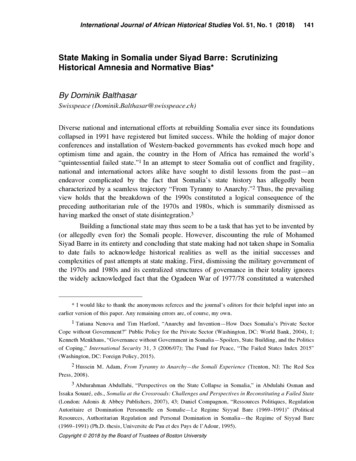
Transcription
International Journal of African Historical Studies Vol. 51, No. 1 (2018)141State Making in Somalia under Siyad Barre: ScrutinizingHistorical Amnesia and Normative Bias*By Dominik BalthasarSwisspeace (Dominik.Balthasar@swisspeace.ch)Diverse national and international efforts at rebuilding Somalia ever since its foundationscollapsed in 1991 have registered but limited success. While the holding of major donorconferences and installation of Western-backed governments has evoked much hope andoptimism time and again, the country in the Horn of Africa has remained the world’s“quintessential failed state.”1 In an attempt to steer Somalia out of conflict and fragility,national and international actors alike have sought to distil lessons from the past—anendeavor complicated by the fact that Somalia’s state history has allegedly beencharacterized by a seamless trajectory “From Tyranny to Anarchy.”2 Thus, the prevailingview holds that the breakdown of the 1990s constituted a logical consequence of thepreceding authoritarian rule of the 1970s and 1980s, which is summarily dismissed ashaving marked the onset of state disintegration.3Building a functional state may thus seem to be a task that has yet to be invented by(or allegedly even for) the Somali people. However, discounting the rule of MohamedSiyad Barre in its entirety and concluding that state making had not taken shape in Somaliato date fails to acknowledge historical realities as well as the initial successes andcomplexities of past attempts at state making. First, dismissing the military government ofthe 1970s and 1980s and its centralized structures of governance in their totality ignoresthe widely acknowledged fact that the Ogadeen War of 1977/78 constituted a watershed* I would like to thank the anonymous referees and the journal’s editors for their helpful input into anearlier version of this paper. Any remaining errors are, of course, my own.1 Tatiana Nenova and Tim Harford, “Anarchy and Invention—How Does Somalia’s Private SectorCope without Government?” Public Policy for the Private Sector (Washington, DC: World Bank, 2004), 1;Kenneth Menkhaus, “Governance without Government in Somalia—Spoilers, State Building, and the Politicsof Coping,” International Security 31, 3 (2006/07); The Fund for Peace, “The Failed States Index 2015”(Washington, DC: Foreign Policy, 2015).2 Hussein M. Adam, From Tyranny to Anarchy—the Somali Experience (Trenton, NJ: The Red SeaPress, 2008).3 Abdurahman Abdullahi, “Perspectives on the State Collapse in Somalia,” in Abdulahi Osman andIssaka Souaré, eds., Somalia at the Crossroads: Challenges and Perspectives in Reconstituting a Failed State(London: Adonis & Abbey Publishers, 2007), 43; Daniel Compagnon, “Ressources Politiques, RegulationAutoritaire et Domination Personnelle en Somalie—Le Regime Siyyad Bare (1969–1991)” (PoliticalResources, Authoritarian Regulation and Personal Domination in Somalia—the Regime of Siyyad Bare(1969–1991) (Ph.D. thesis, Universite de Pau et des Pays de l’Adour, 1995).Copyright 2018 by the Board of Trustees of Boston University
142Dominik Balthasarfor Somalia’s state trajectory,4 which hints at distinct developments in the pre-war ascompared to the post-war era. Second, blaming Somalia’s post-1991 fate on therepercussions of Barre’s dictatorial rule is not only simplistic, but glosses over the fact thatalready the post-independence decade of the 1960s entailed seeds of state fragility andsocial fragmentation—sown, not least, during colonialism. Finally, normative assessmentsof central versus federal and democratic versus autocratic rule are problematic forconfining the debate’s scope to different types of governance, which might not be the mostvital variable in the state-making equation after all.This article argues that the early rule of Barre holds important lessons for statemaking, and furthermore proposes that the early to mid-1970s constituted the mostpromising state-making period in Somali history. Though not conforming to (neo-)liberalidea(l)s about governance and policy making, it was during this period that the countryexperienced increasing degrees of institutional and identity standardization, processesfoundational to state and nation building, cum state making.5 Institutional standardizationunderlies state building and is conceived of as a process whereby a single set of “rules ofthe game”6 gains dominance within a given society—a condition in which all major rolerelationships are regularized by a preponderant organization. Likewise, identitystandardization underlies nation building and is defined as a process whereby one commonset of “rules of the mind”—sociocognitive elements such as language, social norms, ormental maps—becomes dominant within a politically defined population.This novel yet historically and theoretically rooted conceptual framework allowsfor an understanding of processes of state making and state breaking that shed new light onstate-making trajectories. In contrast to neopluralist concepts that are normatively ladenand focus primarily on different forms of governance, this prism focuses on particularprocesses that underlie state trajectories and reunites the long-divided concepts of statebuilding and nation building. Moreover, the framework advances the debate on “hybridpolitical orders” 7 and “institutional multiplicity” 8 by depicting how the plurality ofcoexisting and competing rules is characteristic of state fragility—as evidenced by the4 Paolo Tripodi, The Colonial Legacy in Somalia: Rome and Mogadishu; From ColonialAdministration to Operation Restore Hope (Basingstoke and New York: Macmillan and St. Martin’s Press,1999), 1.5 State building refers to the establishment of institutions and organizations of government. Nationbuilding addresses issues of identity rather than government and implies the creation of a nation. Finally, Iuse the term state making as an umbrella term for processes that encompass state building and nationbuilding. The term state breaking is applied in juxtaposition, used to replace terms such as “state failure” or“collapse.”6 Douglass North, Institutions, Institutional Change and Economic Performance (Cambridge:Cambridge University Press, 1990).7 Volker Böge, Anne Brown, Kevin Clements, Anna Nolan, On Hybrid Political Orders and EmergingStates: State Formation in the Context of “Fragility” (Berlin: Berghof Research Center, 2008).8 Crisis States Research Center, “War, State Collapse and Reconstruction: Phase 2 of the Crisis StatesProgramme,” CSRC Working Paper Series (London: London School of Economics and Political Science,2005).
State Making in Somalia under Siyad Barre143Somali state trajectory of the 1960s—and needs to be replaced by rule conformity andunity for state making to take root. Gaining a better understanding of whether and how theSomali state reached its “high tide” during the early to mid-1970s9 is not only crucial toshed further light on prevailing debates about state fragility and resilience, but also carriesessential implications for contemporary efforts to build a more stable and peaceful Somalistate.This article is based on a critical re-reading of existing scholarship and the analysisof further secondary data on the Somalia of the late 1960s and early to mid-1970s throughthe prism of rule standardization. The information thus discerned was amended byinterviews conducted during field research in Somalia/Somaliland between 2008 and 2011.While the primary data obtained through these interviews was triangulated, the possibilityof these interviewees having exhibited a certain bias cannot be excluded entirely. Althoughthe majority of interview partners acknowledged their own enthusiasm for Barre’s statebuilding project back in the days, the receptivity of the wider society to these effortscannot be determined conclusively.The article is organized as follows. Section one introduces the prism of rulestandardization, revealing that progress or regression in state making does not hinge onparticular types of governance, but is largely dependent on creating predictable ruleframeworks by enforcing common rule systems. Section two sets the empirical stage bybriefly outlining the state-making project of the civilian governments during the first postindependence decade. Against this background, section three analyzes the state trajectoryof the early to mid-1970s. Building on a historical analysis of state making in the 1960s,10this section depicts how the rule plurality that had surfaced in the preceding decade wasabated in favor of increasing institutional and identity standardization, allowing for anassessment of Barre’s early state-making project that challenges commonly held positions.Although a number of sympathetic accounts of some of Barre’s policies can be found inthe literature,11 there is a dearth of analytical investigations into the dictator’s state-makingefforts in the early to mid-1970s—a gap this article aims to address. A conclusionsummarizes the article’s main findings and reflects on their broader implications.9 David Laitin, “The Political Crisis in Somalia,” Horn of Africa 5, 2 (1982), 60; Adam, From Tyrannyto Anarchy, 7.10 Dominik Balthasar, “Somalia: Unable to Escape Its Past? Revisiting the Roots of a Fractured Stateand Elusive Nation,” Critical African Studies 6, 2–3 (2014), 223–39.11 For a favorable account of the literacy program, see e.g., David Laitin, Politics, Language, andThought—The Somali Experience (Chicago: University of Chicago Press, 1977); Ioan Lewis, “The Politics ofthe 1969 Somali Coup,” Journal of Modern African Studies 10, 3 (1972); Ahmed Ismail Samatar, SocialistSomalia—Rhetoric and Reality (London: Zed Books, 1988); Adam Hussein Mohamed, The RevolutionaryDevelopment of the Somali Language, Vol. 20 (Los Angeles: African Studies Center, University ofCalifornia, 1980). Others have lauded the military regime’s accomplishments regarding democratization and“scientific socialism” (Basil Davidson, “Somalia: Towards Socialism,” Race and Class 17 [1975]); GaryPayton, “The Somali Coup of 1969: The Case for Soviet Complicity,” Journal of Modern African Studies 18,3 (1980), 494. For a more general laudation on Barre’s accomplishments, see Luigi Pestalozza, The SomalianRevolution, trans. from Italian by Peter Glendening (Paris: Editions Afrique Asie Amérique latine, 1974).
144Dominik BalthasarState Making as Rule Standardization12Subsequent to a period dominated by the Washington Consensus and its optimisticemphasis on the market, an incremental realization of the need for “Bringing the StateBack In” 13 emerged based on the general acknowledgement that the state plays an“extensive role in strengthening and safeguarding human capabilities.” 14 Ever since,largely liberal ideas have guided the international community’s handbooks on how tosupposedly “fix” fragile states.15 While the decade after 1991 saw attention focus on“weak,” “failed,” and “collapsed” states,16 the post-2001 era experienced a shift to themore programmatic issue of “state-building.”17As the 2000s drew to an end, concepts of “twilight institutions,”18 the “negotiatedand “hybrid political orders” (HPOs)20 heralded a further rethinking of the stateand issues of governance in contexts of contested statehood. Despite the valuablecontributions made by conceptualizations that put notions of hybridity and pluralism atcenter stage, they also exhibit important limitations. Among other things, they areconceptually limited to distinguish those HPOs that are constitutive of state making fromthose that are detrimental to it. Moreover, they remain captive to the neoliberal “diversitystate,”1912 For a more detailed elaboration of the analytical framework presented here, see Dominik Balthasar,“From Hybridity to Standardization: Rethinking State-Making in Contexts of Fragility,” Journal ofIntervention and Statebuilding 9, 1 (2015).13 Peter Evans, Dietrich Rueschmeyer, and Theda Skocpol, Bringing the State Back In (Cambridge:Cambridge University Press, 1985).14 Amartya Sen, Development as Freedom (New York: Knopf, 1999), 5.15 Ashraf Ghani and Clare Lockhart, Fixing Failed States: A Framework for Rebuilding a FracturedWorld (Oxford: Oxford University Press, 2008); Seth Kaplan, Fixing Fragile States—A New Paradigm forDevelopment (London: Praeger Security International, 2008).16 Robert Jackson, Quasi-States: Sovereignty, International Relations and the Third World(Cambridge: Cambridge University Press, 1990); Jean-François Bayart, The State in Africa: The Politics ofthe Belly (New York: Longman, 1993); William Zartman, ed., Collapsed States: The Disintegration andRestoration of Legitimate Authority (Boulder, CO: Lynne Rienner, 1995).17 Derick Brinkerhoff, “Governance Challenges in Fragile States: Re-Establishing Security, RebuildingEffectiveness, and Reconstituting Legitimacy,” in Derick Brinkerhoff, ed., Governance in Post-ConflictSocieties—Rebuilding Fragile States (New York: Routledge, 2007); Ghani and Lockhart, Fixing FailedStates; Organisation for Economic Co-Operation and Development (OECD), “Concepts and Dilemmas ofState Building in Fragile Situations—From Fragility to Resilience,” ed. Development Assistance Committee(DAC) (Paris: OECD, 2008).18 Christian Lund, “Twilight Institutions: Public Authority and Local Politics in Africa,” Developmentand Change 37, 4 (2006).19 Menkhaus, “Governance without Government.”20 Böge et al., On Hybrid Political Orders.
State Making in Somalia under Siyad Barre145myth,” 21 according to which societal pluralism is a precondition for, rather than anoutcome of past and present state development.Re-Conceptualizing Contested StatehoodThere are grounds to argue that state making is propelled more by developments thatenhance degrees of unification, homogenization, or standardization than by policies gearedtoward strengthening liberal pluralism. Levene,22 for example, argues that states did notexist to promote diversity, but, “on the contrary, their role is to streamline, makehomogeneous, organize people to be uniform in some sense.”23 Such thinking is broadlycompatible with classical approaches to state building,24 all of which propose that theconflicting plurality of actors needs to be replaced with a “Principe” or “Leviathan,” whoholds a monopoly of the legitimate means of physical violence.25Casting such reasoning in the language of new institutional economics,26 accordingto which institutions can be understood as “humanly devised, recognized and enforceable‘rules of the game’ that govern the behaviour, rights and obligations of two or moreindividuals by creating regularised role relationships,”27 state making appears as a processby which “institutional multiplicity” or the patchwork of “political orders” is replaced by aframework that dispenses with ambiguities emanating from the coexistence of diverse andcompeting sets of “rules of the game.” Whether such standardization is achieved byintroducing new institutions in addition to or in lieu of existing ones, or by altering theprevailing institutional framework by means of establishing hierarchies—which can beconceived of as institutions by other means as they, too, contribute to reducing21 Benjamin Schwarz, “The Diversity Myth: America’s Leading Export,” Atlantic Monthly 275, 5(1995).22 Mark Levene, “The Limits of Tolerance: Nation-State Building and What It Means for MinorityGroups,” Patterns of Prejudice 34, 2 (2000), 21.23 See also Benedict Anderson, Imagined Communities: Reflections on the Origin and Spread ofNationalism (London: Verso, 1983); Walker Connor, Ethnonationalism: The Quest for Understanding(Princeton, NJ: Princeton University Press, 1994), 92; D. Conversi, “Homogenisation, Nationalism and War:Should We Still Read Ernest Gellner?” Nations and Nationalism 13, 3 (2007), 372.24 Niccolò Machiavelli, “The Prince. Edited by Skinner, Q. & Price, R. (1988)” (Cambridge:Cambridge University Press, 1513); Jean-Jaques Rousseau, Du Contrat Social ou Principes du DroitPolitique (Amsterdam: Chez M.M. Rey, 1763).25 Max Weber, “Politics as a Vocation,” in D. Owen, T. Strong and R. Livingstone, eds., The VocationLectures (Indianapolis, IN: Hackett Publishers, 1919).26 R. Coase, “The Problem of Social Cost,” Journal of Law and Economics 3, 1 (1960); North,Institutions, Institutional Change.27 Douglas North, “The New Institutional Economics and Third World Development,” in J. Harriss, J.Hunter, and C. Lewis, eds., The New Institutional Economics and Third World Development (London:Routledge, 1995); James Putzel, “Survival of an Imperfect Democracy in the Philippines,” Democratization6, 1 (1999); J. Harriss, “Institutions, Politics and Culture: A Case for ‘Old’ Institutionalism in the Study ofHistorical Change,” in Destin Working Paper. Development Studies Institute (London: London School ofEconomics and Political Science, 2002).
146Dominik Balthasaruncertainty28—is secondary; what is key is that the same institutions are broadcasted andenforced among a given population.Interestingly, it is in this line of thought that fragile and contested states have—despite the celebration of pluralism—come to be understood as “places in which diverseand competing claims to power and logics of order co-exist, overlap and intertwine,”29allowing actors to “[switch] strategically from one institutional universe to another.”30 Ifthis characterization of fragile states is correct, then their very quality defies the largerpurpose of institutions, namely to “reduce uncertainty.”31 In order to overcome suchinstitutional insecurity, the “hybridity” of “political orders” or multiplicity of institutionslogically needs to give way to the enforcement of an authoritative set of “rules of thegame” and “rules of the mind.” Thus, it is the standardization and hierarchization, ratherthan pluralization and equalization of rules that apparently lies at the heart of stateconsolidation.“Bringing the Nation Back In”The scholarship’s ubiquitous focus on institutions glosses over another critical aspect ofstate making: identities in general, and the nation in particular. Yet, given inherent linksbetween the state and society,32 “simply putting in place the formal rules is a recipe fordisappointment, not to say disaster.”33 Consequently, Lemay-Hébert correctly argues thatthe process of (re)building states cannot be effective, if focusing on state institutions alone,but that it also needs to take sociopolitical aspects into account.34 As “the creation ofinstitutions has concrete repercussions on the nature of the socio-political cohesion,”35state building and nation building are anything but “opposing forces.”36 Rather, they aredialectic processes, leading us to propose in a manner analogous to the dictum of Evans,Rueschmeyer, and Skocpol on the state, the need of “bringing the nation back in.”37As shown elsewhere,38 nation building can be understood in similar terms as statebuilding; a process in which a common, state-related identity comes to be shared by a28 Douglass North, Understanding the Process of Economic Change (Princeton, NJ: PrincetonUniversity Press, 2005), 1.29 Böge et al., On Hybrid Political Orders, 10.30 Crisis States Research Center, “War, State Collapse and Reconstruction,” 8.31 North, Institutions, Institutional Change, 3.32 Joel Migdal, State in Society: Studying How States and Societies Transform and Constitute OneAnother (Cambridge: Cambridge University Press, 2001).33 North, Understanding the Process of Economic Change, 161.34 Nicolas Lemay-Hébert, “Statebuilding without Nation-Building? Legitimacy, State Failure and theLimits of the Institutionalist Approach,” Journal of Intervention and Statebuilding 3, 1 (2009), 22.35 Ibid., 32.36 Marina Ottaway, “Nation Building and State Disintegration,” in Ken Menkhaus and Diane Davis,eds., State Building and Democratization in Africa—Faith, Hope and Realities (London: Praeger, 1999).37 Evans, Rueschmeyer, and Skocpol, Bringing the State Back In.38 Balthasar, “From Hybridity to Standardization.”
State Making in Somalia under Siyad Barre147territorially defined population. This process can be nurtured by spreading andstandardizing existing sociocognitive elements (e.g., by declaring one vernacular as theofficial language) or by introducing a new set of “rules of the mind” across the wholepopulation (e.g., by announcing a political ideology). That nation building is eventuallyabout the standardization of social and/or cognitive patterns is the theme underlyingnumerous accounts of nationalism. Whether brought about by linguistic unification,39media and education, 40 industrialization, 41 urbanization, 42 or warfare, 43 the commondenominator of these accounts of nationalism lies in the convergence of a society’s “rulesof the mind,” i.e., identity standardization.44While Ottaway warns that “[a]ttempts at ‘homogenising’ a state from an ethnicperspective are not appropriate,”45 Conversi46 and Levene47 argue that “homogenization”played a central role in nation building. Connor, for another, even understands a nation tobe a “social group that shares [ ] a sense of homogeneity.”48 Just as “[t]he powerfulinfluence of myths, superstitions, and religions in shaping early societies came from theirrole in establishing order and conformity,” so nationalism to this day is “a major force inreducing the costs of maintaining order.”49Therefore, it has to be acknowledged that with regard to aspects of ethnicity, forexample, the process of “homogenizing” necessitates neither the cleansing of ethnicminorities, nor cleaning the minorities of their ethnicity. In fact, such efforts can seriouslybackfire on state-making projects, as they are likely to elicit an affirmation of subnationalidentities, rather than allowing for the construction of an overarching identity. While theelimination of ethnic, religious, and other minorities has historically constituted a commonmeans to arrive at institutional and identity standardization, the latter has also frequentlyresulted from adding another, overarching set of “rules of the mind,” such as a national39 Anderson, Imagined Communities.40 E.J. Hobsbawm, The Age of Revolution: 1789–1846 (London: Cardinal, 1977).41 Ernest Gellner, Nations and Nationalism (Oxford: Blackwell, 2006).42 M. Szilagyi-Gal, “The Nationality of Reasoning: Autochthonist Understandings of Philosophy inInterwar Romania,” in Balázs Trencsényi, Dragos Petrescu, Cristina Petrescu, Constantin Iordachi, and ZltánKántor eds., Nation-Building and Contested Identities: Romanian and Hungarian Case Studies (Budapest:Regio Books, 2001).43 Charles Tilly, Coercion, Capital, and European States, A.D. 990–1990 (Cambridge, MA: BasilBlackwell, 1992).44 Something that Deutsch might call “assimilation.” Karl Deutsch, Nationalism and SocialCommunication: An Inquiry into the Foundations of Nationality (Cambridge, MA: Massachusetts Institute ofTechnology Press, 1953).45 Ottaway, “Nation Building and State Disintegration,” as quoted in Z. Scott, “Literature Review onState-Building” (Birmingham: Governance and Social Development Resource Center, 2007), 5.46 Conversi, “Homogenisation, Nationalism and War.”47 Levene, “The Limits of Tolerance.”48 Connor, Ethnonationalism, 92, my italics.49 North, Understanding the Process of Economic Change, 42.
148Dominik Balthasaridentity, to a society’s identity framework. Such a procedure could not only counter asociety’s potentially perceived need for ethnic standardization—a process likely to beviolent due to the rather rigid and exclusionary nature of ethnic identities50—but could alsoprovide the basis for a better social integration of ethnic minorities.Advancing Somali State Making in the Early to Mid-1970sFragility Sets the StageFive days after the assassination of Somali President Abdirashid Ali Shermarke, the armycarried out a bloodless coup d’état on 21 October 1969. Having occupied strategiclocations within Mogadishu, coup leader Mohamed Siyad Barre immediately moved todissolve the institutions of civilian government. 51 While he suspended the NationalAssembly and the Supreme Court, abolished all political parties, and abrogated theconstitution within hours of the coup, Barre announced the drafting of a new constitutionand the ruling of the country by decree in the interim. Subsequent months saw the creationof an “institutional tabula rasa,”52 followed by several institutional and administrativealterations,53 seeing the population benefitting from “improved economic performance,expanding social services and a better culture of governance.”54Indeed, the military take over marked a decisive turn in Somali state development.The most fundamental change was in the trajectory of prevailing rule frameworks, whichwas characterized by a switch from institutional and identity plurality to a process thatregistered a standardization of dominant “rules of the game” and “rules of the mind.”While scholars had described Somalia as being marked by ethnic, cultural, linguistic, andreligious homogeneity in the years around and subsequent to independence in 1960,55suggesting that Somalis formed one of the rare true nations on sub-Saharan African soil,5650 D. Turton, War and Ethnicity: Global Connections and Local Violence (Rochester, NY: Universityof Rochester Press, 1997), 3.51 Born in 1919 to a pastoralist family, Barre was educated as police officer under Italian colonial rule.Upon independence, Barre became vice commander of the Somali army, and became commander in chief in1966.52 Compagnon, “Ressources Politiques,” 305.53 International Center for Public Enterprises in Developing Countries, “The Role of the Public Sectorin Developing Countries,” in ICPE Country Studies Series (Ljubljana, Yugoslavia, 1983), 38; David Laitin,“Somalia’s Military Government and Scientific Socialism,” in Carl Roseberg and Thomas Callaghy, eds.,Socialism in Sub-Saharan Africa—A New Assessment (Berkeley: University of California Press, 1979), 18;Ioan Lewis, A Pastoral Democracy: A Study of Pastoralism and Politics among the Northern Somali of theHorn of Africa (New York: Africana Publishing for the International African Institute, 1982), 178; Adam,From Tyranny to Anarchy, 7.54 Abdullahi, “Perspectives on the State Collapse in Somalia,” 43.55 Alphonso Castagno, “Somalia,” International Conciliation 522 (1959), 340; C. J. Martin, “TheSomali Republic” The British Survey 203 (1966), 2.56 Louis Fitzgibbon, The Betrayal of the Somalis (London: Rex Collings, 1982), 2; David Laitin andSaid S. Samatar, Somalia: Nation in Search of a State (Boulder, CO: Westview, 1987), xiv.
State Making in Somalia under Siyad Barre149this claim was not supported by the underlying institutional plurality. This plurality, whichhad partly been inherited from colonialism, constituted a significant obstacle to statemaking.57While the Ise Somalis residing in French Somalia (today’s Djibouti) shared apolitical vision distinct from the ones of other Somali communities,58 Ogaden Somalismoulded an identity of their own given the different institutions they had been subjected tounder Ethiopian rule.59 But also within the newly formed Somali Republic, institutionaland identity fragmentation prevailed as the two territories differed in administrative, legal,fiscal, and linguistic terms, among others. 60 The fact that the 1960s also witnessedincreasing social stratification based on urban-rural, regional, and linguistic differentials,61and that Somali society developed into a “semi-anarchy” of clan-based camps furtherindicates how the 1960s were marked by a pluralization rather than standardization ofrules.62 This “disorder that had discredited and deadlocked the previous parliamentarysystem” stood in stark contrast with the “order that the military brought to Somalipolitics.”63Streamlining the Administration: Setting the Conditions for Rule StandardizationWith the take over of the military government, administrative structures experienced asignificant boost and reorganization. At the central level, Barre replaced the cabinet andthe National Assembly with the Supreme Revolutionary Council (SRC), which consistedof twenty-five high-ranking members of the security forces and ruled, in the form of anexecutive committee, along the institutional and ideological framework set out in the FirstCharter of the Revolution of 1969. The SRC was complemented by a subordinate Councilof the Secretaries of State, which was composed of fourteen mainly civilian secretarieswho were responsible for the day-to-day government operations. 64 While the SRC57 Balthasar, “Somalia: Unable to Escape Its Past.”58 Ioan Lewis, A Modern History of the Somali: Nation and State in the Horn of Africa (Oxford: JamesCurrey, 2002), 136.59 Saadia Touval, Somali Nationalism: International Politics and the Drive for Unity in the Horn ofAfrica (Cambridge, MA: Harvard University Press, 1963), 107; Ian Spears, Civil War in African States: TheSearch for Security (Boulder, CO: FirstForumPress, 2010), 122.60 Ioan Lewis, “Integration in the Somali Republic,” in Arthur Hazlewood, ed., African Integration andDisintegration—Case Studies in Economic and Political Union (London: Oxford University Press, 1967),272; Abdi Ismail Samatar, “Structural Adjustment as Development Strategy? Bananas, Boom, and Poverty inSomalia,” Economic Geography 69, 1 (1993), 27.61 David Laitin, “The Political Economy of Military Rule in Somalia,” Journal of Modern AfricanStudies 14, 3 (1976), 463.62 Adam, From Tyranny to Anarchy, 1.63 Spears, Civil War in African States, 134.64 Samatar, “Structural Adjustment as Development Strategy?” 38. With the exception of policecommissioner Major-General Jama Ali Korshel, who was put in charge of Internal Affairs in addition tobeing vice-president of the SRC, the other thirteen secretaries of state were “youngish civilian technocrats,”whose appointment was allegedly marked by “an attempt at subordinating ethnic considerations to individua
Cambridge University Press, 1985). 14 Amartya Sen, Development as Freedom (New York: Knopf, 1999), 5. 15 Ashraf Ghani and Clare Lockhart, Fixing Failed States: A Framework for Rebuilding a Fractured World (Oxford: Oxford University Press, 2008); Seth Kaplan, Fixing Fragile States—A New Paradigm for

